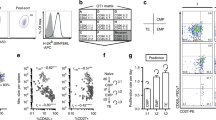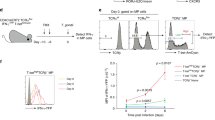Abstract
The initial encounter with an antigen-presenting cell (APC) is the primary force behind the expansion, differentiation and survival of naive T cells. Using an APC that permits temporal control of priming, we examined whether the duration of antigenic stimulation can influence the functional development of CD8+ cytotoxic T lymphocytes (CTLs) in vivo. Whereas CTLs given a 4-h stimulus underwent an abortive clonal expansion with transient surface CD25 expression, those given a 20-h stimulus sustained CD25 up-regulation, proliferated extensively, and efficiently mediated destruction of peripheral target tissues. Our results show that an instructional program preceding the first cell division integrates differences in signal strength into the decision to activate versus tolerize specific CTL clones.
This is a preview of subscription content, access via your institution
Access options
Subscribe to this journal
Receive 12 print issues and online access
$209.00 per year
only $17.42 per issue
Buy this article
- Purchase on Springer Link
- Instant access to full article PDF
Prices may be subject to local taxes which are calculated during checkout




Similar content being viewed by others
References
Harty, J.T., Tvinnereim, A.R. & White, D.W. CD8+ T cell effector mechanisms in resistance to infection. Annu. Rev. Immunol. 18, 275–308 (2000).
Kaech, S.M., Wherry, E.J. & Ahmed, R. Effector and memory T-cell differentiation: implications for vaccine development. Nat. Rev. Immunol. 2, 251–262 (2002).
Murali-Krishna, K. et al. Counting antigen-specific CD8 T cells: a reevaluation of bystander activation during viral infection. Immunity 8, 177–187 (1998).
Butz, E.A. & Bevan, M.J. Massive expansion of antigen-specific CD8+ T cells during an acute virus infection. Immunity 8, 167–175 (1998).
Blattman, J.N. et al. Estimating the precursor frequency of naive antigen-specific CD8 T cells. J. Exp. Med. 195, 657–664 (2002).
Lanzavecchia, A. & Sallusto, F. Dynamics of T lymphocyte responses: intermediates, effectors, and memory cells. Science 290, 92–97 (2000).
Heath, W.R. & Carbone, F.R. Cross-presentation, dendritic cells, tolerance and immunity. Annu. Rev. Immunol. 19, 47–64 (2001).
Steinman, R.M. & Nussenzweig, M.C. Avoiding horror autotoxicus: the importance of dendritic cells in peripheral T cell tolerance. Proc. Natl. Acad. Sci. USA 99, 351–8 (2002).
Iezzi, G., Karjalainen, K. & Lanzavecchia, A. The duration of antigenic stimulation determines the fate of naive and effector T cells. Immunity 8, 89–95 (1998).
Iezzi, G., Scotet, E., Scheidegger, D. & Lanzavecchia, A. The interplay between the duration of TCR and cytokine signaling determines T cell polarization. Eur. J. Immunol. 29, 4092–4101 (1999).
van Stipdonk, M.J., Lemmens, E.E. & Schoenberger, S.P. Naive CTLs require a single brief period of antigenic stimulation for clonal expansion and differentiation. Nat. Immunol. 2, 423–429 (2001).
Kaech, S.M. & Ahmed, R. Memory CD8+ T cell differentiation: initial antigen encounter triggers a developmental program in naive cells. Nat. Immunol. 2, 415–422 (2001).
Wong, P. & Pamer, E. Antigen-independent CD8 T cell proliferation. J. Immunol. 166, 5864–5868 (2001).
Miller, M.J., Wei, S.H., Parker, I. & Cahalan, M.D. Two-photon imaging of lymphocyte motility and antigen response in intact lymph node. Science 296, 1869–1873 (2002).
Stoll, S., Delon, J., Brotz, T.M. & Germain, R.N. Dynamic imaging of T cell–dendritic cell interactions in lymph nodes. Science 296, 1873–1876 (2002).
Schoenberger, S.P. et al. Efficient direct priming of tumor-specific cytotoxic T lymphocyte in vivo by an engineered APC. Cancer Res. 58, 3094–3100 (1998).
Hogquist, K.A. et al. T cell receptor antagonist peptides induce positive selection. Cell 76, 17–27 (1994).
Plas, D., Rathmell, J. & Thompson, C. Homeostatic control of lymphocyte survival: potential origins and implications. Nat. Immunol. 3, 515–521 (2002).
Chao, D. et al. Bcl-XL and Bcl-2 repress a common pathway of cell death. J Exp Med 182, 821–828 (1995).
Strasser, A., Harris, A. & Cory, S. bcl-2 transgene inhibits T cell death and perturbs thymic self-censorship. Cell 67, 889–899 (1991).
Dai, Z., Konieczny, B. & Lakkis, F. The dual role of IL-2 in the generation and maintenance of CD8+ memory T cells. J. Immunol. 165, 3031–3036 (2000).
Oehen, S. & Brduscha-Riem, K. Differentiation of naive CTL to effector and memory CTL: correlation of effector function with phenotype and cell division. J. Immunol. 161, 5338–5346 (1998).
Kurts, C., Kosaka, H., Carbone, F.R., Miller, J.F. & Heath, W.R. Class I-restricted cross-presentation of exogenous self-antigens leads to deletion of autoreactive CD8+ T cells. J. Exp. Med. 186, 239–245 (1997).
Kurts, C. et al. CD4+ T cell help impairs CD8+ T cell deletion induced by cross- presentation of self-antigens and favors autoimmunity. J. Exp. Med. 186, 2057–2062 (1997).
Nelson, B. & Willerford, D. The biology of the interleukin-2 receptor. Adv. Immunol. 70, 1–81 (1998).
Liu, K. et al. Immune tolerance after delivery of dying cells to dendritic cells in situ. J. Exp. Med. 196, 1091–1097 (2002).
Acknowledgements
This is manuscript no. 529 from the La Jolla Institute for Allergy and Immunology, La Jolla, CA. Supported by grants from the American Cancer Society, the National Institutes of Health, Cap CURE and the Netherlands Cancer Society.
Author information
Authors and Affiliations
Corresponding author
Ethics declarations
Competing interests
The authors declare no competing financial interests.
Supplementary information
Rights and permissions
About this article
Cite this article
van Stipdonk, M., Hardenberg, G., Bijker, M. et al. Dynamic programming of CD8+ T lymphocyte responses. Nat Immunol 4, 361–365 (2003). https://doi.org/10.1038/ni912
Received:
Accepted:
Published:
Issue Date:
DOI: https://doi.org/10.1038/ni912
This article is cited by
-
Malabaricone C, a constituent of spice Myristica malabarica, exhibits anti-inflammatory effects via modulation of cellular redox
Journal of Biosciences (2023)
-
The timing of differentiation and potency of CD8 effector function is set by RNA binding proteins
Nature Communications (2022)
-
CpG-ODN induced antimicrobial immunity in neonatal chicks involves a substantial shift in serum metabolic profiles
Scientific Reports (2021)
-
The phosphatase PAC1 acts as a T cell suppressor and attenuates host antitumor immunity
Nature Immunology (2020)
-
Tissue-resident memory CD8+ T cells shape local and systemic secondary T cell responses
Nature Immunology (2020)



